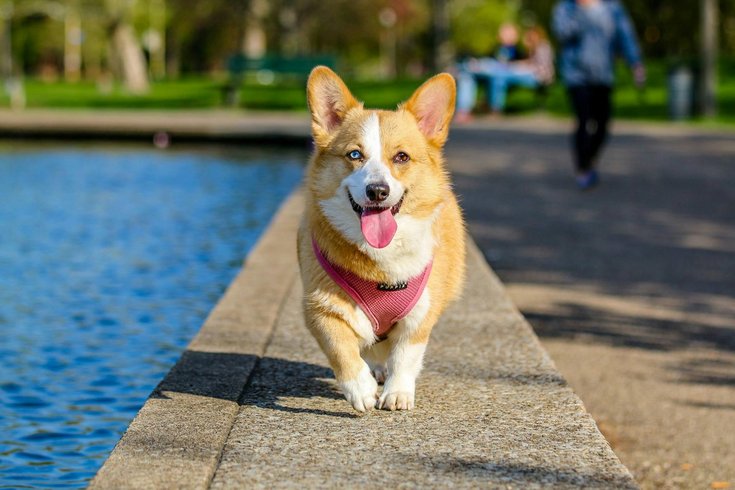
June 19, 2024
 muhannad alatawi/Pexels
muhannad alatawi/Pexels
If outside during hot weather, dogs and cats should have constant access to water or shade and always be supervised.
As temperatures climb toward 100 degrees in the region this week, pet owners should keep their furry friends in mind to protect them from heatstroke and other dangerous heat-related conditions.
Here are some tips from Heart + Paw, which has several veterinary centers in Philadelphia, and the American Society for the Prevention of Cruelty to Animals to keep pets safe during the sweltering heat:
A foolproof way to keep your animals safe in the warm weather is to leave them inside as much as possible. They should not be engaging in active play or high-energy activities outside when it's 80 degrees or higher. The ideal times for walks would be in the early morning or evening, when temperatures are not at their highest. People may consider bringing outdoor cats inside if possible when the weather reaches extreme temperatures.
If the air temperature outside is the same or higher than your pet's base body temperature, then they can quickly experience heatstroke or heat exhaustion symptoms, according to Heart + Paw. Dogs typically have base body temperatures between 100 and 102.5 degrees Fahrenheit, while cats are usually between 101 and 102.5.
Different cat and dog breeds may have different tolerances to the heat. For example, small-breed and medium-breed dogs should avoid going outside when the temperature is 90 degrees or higher, while large-breed dogs should stay inside when it's 85 degrees or higher, according to Heart + Paw.
Also, dogs and cats with short, flat snouts — like pugs and Persian cats — may have more difficulty breathing in higher temperatures because they cannot pant as effectively as other breeds, according to the ASPCA. These types of pets, along with animals that are overweight, elderly and have heart or lung disease, should be kept in air-conditioned rooms as often as possible.
Pets that are longhaired or have thick, curly coats are also more likely to overheat quicker, but grooming can help. Brushing cats more often than usual in the warm months can prevent excessive heat-related problems. When it comes to dogs, the ASPCA said they can be trimmed but should never be shaved because the layers of dogs' coats can help protect them from overheating and sunburn.
If you do need to take your pet for a walk when it's hot outside, keep the walk short and make sure to provide an abundance of fresh water. Pets can get dehydrated quickly when it's hot or humid outside. Pet owners should bring a bowl and water any time they are taking their pet on an outdoor outing, and they should also make sure they have plenty of shade to rest in and avoid the sun if they do need to be outside.
It is possible for dogs to get sunburn — especially in dogs that are hairless or have pale noses, like whippets or Dalmatians — and humans can take steps to protect them by using pet-friendly sunscreen or UV-protected sun shirts.
It's important to keep an eye out for the symptoms of heat-related conditions in pets if they are spending time outside this summer. Signs of heatstroke can include:
• Excessive panting or difficulty breathing (Regular panting is normal for dogs, but a cat should be taken to the vet immediately if it is panting.)
• Increased heart and respiratory rate
• Drooling
• Mild weakness, lethargy, stupor or collapse
• Dry gums
• Refusal to eat
• Sunken eyes
• Decreased skin elasticity, which can be measured by pinching the pet's skin between the shoulder blades and lifting to form a tent. If the skin is slow to snap back to normal, the pet is likely dehydrated.
More severe symptoms can include seizures, bloody diarrhea, vomit and an elevated body temperature of more than 104 degrees.
If a pet shows any of the above signs, you can attempt to cool them down using fans or ice packs, or by hosing them down with water. If this does not seem to help, the pet should be taken to the vet as soon as possible. Heatstroke is an emergency situation and can lead to death if not quickly addressed, according to Heart + Paw.
In order to ensure pets' safety in the summer, owners should always keep an eye on them when they are outside.
Pets should not be allowed to linger on hot asphalt when the temperature is high. Their bodies can heat up quickly since they are so low to the ground, and their paw pads can burn. Plenty of retailers offer dog booties, shoes or paw protectors that can shield their feet from the hot asphalt or cement.
It may seem like a good idea to allow furry friends to cool off in the water, but they should never be left unsupervised around a pool, lake or on the beach near the ocean. People should also make sure to provide their pets with fresh water and make sure they are not ingesting water from the pool, ocean or lake. After swimming, a dog should be rinsed off to remove chlorine or salt from their fur, the ASPCA says.
Pets should never be left alone in a vehicle, even for a few minutes or on cooler summer days. In a car, the temperature can quickly rise to life-threatening levels, even when the windows are cracked. When the weather is 70 degrees outside, a vehicle can heat up to 89 degrees in 10 minutes, and up to 104 degrees in 30 minutes, Heart + Paw says. At 95 degrees outside, the inside of a car can reach 115 degrees in only 10 minutes.
Follow Franki & PhillyVoice on Twitter: @wordsbyfranki
| @thePhillyVoice
Like us on Facebook: PhillyVoice
Have a news tip? Let us know.